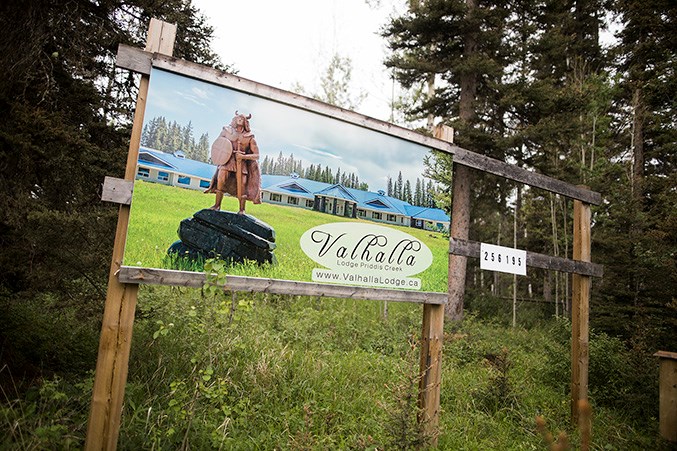A Priddis property with a long history of development applications which have not been approved or followed through will remain undeveloped. MD of Foothills council decided on June 27 to deny an application made by Valhalla Lodge to open an addiction treatment facility on 46.16 acres of land owned by Ole Smed, whose sister originally built a facility intended to be a seniors’ residence. Though the building shell was constructed in 1991, the residence never opened. “It was never completed and was not considered for any uses until we jump ahead 15 years,” said MD planner Heather McInnis. In 2006, council approved an 18-hole golf course and spa that was to be called Valhalla Valley Gold Course, on the condition the applicants secure water licensing for the property. A development permit was never applied for and the building remained unfinished, she said. A development permit application in 2015 sought to turn the structure into a corporate retreat, but that application was withdrawn before it came before council, she said. The proposed addiction treatment facility would include a 1,904 square-foot dwelling for the property manager, a 450 square-foot water treatment structure, an 18,600 square-foot recreational building, a 17,900 square-foot staff residence and detox building to hold 32 staff and up to 20 detox clients, and a 4,844 square-foot wastewater treatment plant. Water storage and wastewater treatment were a concern for many residents and council. “The applicants are proposing to haul in potable water,” said McInnis. “The site is proposed to include a wastewater collection system, mechanical wastewater treatment plant, proposed at 4,300 square feet with an effluent dispersal system.” Due to its proximity to residential buildings, council would have to apply to Alberta Environment to have setbacks for the wastewater treatment plant relaxed, she said. According to the Municipal Government Act, schools, hospitals, food establishments or residences cannot be within 300 metres from the working area of an operating wastewater treatment plant, she said. “The setbacks for the effluent field were not provided to the detox facility or the dwelling, only the setbacks to the plant were provided,” McInnis told council. The plant fell within 188 metres of the existing dwelling, 195 metres of the proposed detox and staff residence building, 270 metres of property owners to the south and 250 metres of its neighbours to the east. However, there was no documentation to show how close the effluent field fell to any of those buildings, she said. MD director of planning Heather Hemingway said the municipality has requested setback requests from the Alberta government in the past. “But we do of course need the technical information associated with the fields, those specifications,” said Hemingway. “Subsequent to that council could make a request to Alberta Environment to allow for the variance on the setback.” If the variance was approved by Alberta Environment, the MD would be responsible for any odour or other concerns and complaints regarding the wastewater treatment plant, she said. A number of area residents attended the public hearing on June 27 to express concerns with Valhalla Lodge, including effects of the wastewater treatment plant, traffic from staff and clients – which Valhalla estimated at 36 vehicles per day – screening, and environmental impact. Lee Thiessen, who owns adjacent lands, spoke with concern specifically regarding his unsold residential lots located nearby. He said more information was required with regards to screening and relaxation to the wastewater treatment plant, and any potential septic seepage issues with his wells in the area. “I am not against this development,” Thiessen told council. “But this isn’t three or four homes being brought in, it’s a very complicated development.” He said Valhalla needed to provide more information, like a traffic impact study, before moving forward. In an interview, he said he was pleased with council’s decision to refuse the application. “There was not enough information for the adjacent landowners to understand the effects and impacts,” said Thiessen. “I was impressed with council. They were objective and pragmatic, but also tough.” Reeve Larry Spilak said council didn’t have any problems with the notion of Valhalla Lodge itself, but the required amounts of water and the wastewater setbacks didn’t seem to fit the location. “It’s too bad, because I think it would be a great facility to have,” said Spilak. He said provisions need to be made to have sufficient water and wastewater piped in and out, because there is a limited amount of land and a creek running through the property. “I think the provisions that are necessary there would be to somehow find a better way of servicing it more reliably without affecting the environment,” said Spilak. Coun. Suzanne Oel said more information was needed in order to apply for a variance on wastewater setbacks. It could come back as another application at a later date, she said. “There were many things about the application that were interesting, but the information could not be fully evaluated because it was not complete,” said Oel. “Some pieces of crucial information were missing as to the effect of the facility on the area.” Valhalla Lodge was not available for comment prior to publication. The Valhalla Lodge website was not operational on June 30, but is now up.




